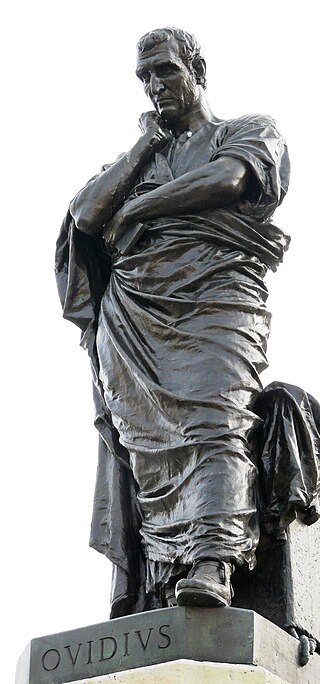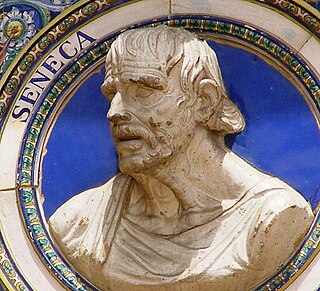
Rhetoric is the art of persuasion. It is one of the three ancient arts of discourse (trivium) along with grammar and logic/dialectic. As an academic discipline within the humanities, rhetoric aims to study the techniques that speakers or writers use to inform, persuade, and motivate their audiences. Rhetoric also provides heuristics for understanding, discovering, and developing arguments for particular situations.

Rodolphus Agricola was a Dutch humanist of the Northern Low Countries, famous for his knowledge of Latin and Greek. He was an educator, musician, builder of church organs, a poet in Latin and the vernacular, a diplomat, a boxer and a Hebrew scholar towards the end of his life. Today, he is best known as the author of De inventione dialectica, the father of Northern European humanism and a zealous anti-scholastic in the late fifteenth century.
A sophist was a teacher in ancient Greece in the fifth and fourth centuries BCE. Sophists specialized in one or more subject areas, such as philosophy, rhetoric, music, athletics and mathematics. They taught arete, "virtue" or "excellence", predominantly to young statesmen and nobility.
Marcus Cornelius Fronto, best known as Fronto, was a Roman grammarian, rhetorician, and advocate. Of Berber origin, he was born at Cirta in Numidia. He was suffect consul for the nundinium of July–August 142 with Gaius Laberius Priscus as his colleague. Emperor Antoninus Pius appointed him tutor to his adopted sons, the future emperors Marcus Aurelius and Lucius Verus.

Marcus Fabius Quintilianus was a Roman educator and rhetorician born in Hispania, widely referred to in medieval schools of rhetoric and in Renaissance writing. In English translation, he is usually referred to as Quintilian, although the alternate spellings of Quintillian and Quinctilian are occasionally seen, the latter in older texts.
Choricius of Gaza was a Gaza-based Greek sophist and rhetorician of Late Antiquity. With writings dating to the early sixth century, he flourished in the time of Anastasius I as a scholar and public orator. He is considered as part of the Rhetorical School of Gaza, of which he later became the chair.
Lucius Annaeus Seneca the Elder, also known as Seneca the Rhetorician, was a Roman writer, born of a wealthy equestrian family of Corduba, Hispania. He wrote a collection of reminiscences about the Roman schools of rhetoric, six books of which are extant in a more or less complete state and five others in epitome only. His principal work, a history of Roman affairs from the beginning of the Civil Wars until the last years of his life, is almost entirely lost to posterity. Seneca lived through the reigns of three significant emperors; Augustus, Tiberius and Caligula. He was the father of Lucius Junius Gallio Annaeanus, best known as a Proconsul of Achaia; his second son was the dramatist and Stoic philosopher Seneca the Younger (Lucius), who was tutor of Nero, and his third son, Marcus Annaeus Mela, became the father of the poet Lucan.

The Second Sophistic is a literary-historical term referring to the Greek writers who flourished from the reign of Nero until c. 230 AD and who were catalogued and celebrated by Philostratus in his Lives of the Sophists. However, some recent research has indicated that this Second Sophistic, which was previously thought to have very suddenly and abruptly appeared in the late 1st century, actually had its roots in the early 1st century. It was followed in the 5th century by the philosophy of Byzantine rhetoric, sometimes referred to as the Third Sophistic.

Progymnasmata are a series of preliminary rhetorical exercises that began in ancient Greece and continued during the Roman Empire. These exercises were implemented by students of rhetoric, who began their schooling between ages twelve and fifteen. The purpose of these exercises was to prepare students for writing declamations after they had completed their education with the grammarians. There are only four surviving handbooks of progymnasmata, attributed to Aelius Theon, Hermogenes of Tarsus, Aphthonius of Antioch, and Nicolaus the Sophist.
Philodemus of Gadara was an Epicurean philosopher and poet. He studied under Zeno of Sidon in Athens, before moving to Rome, and then to Herculaneum. He was once known chiefly for his poetry preserved in the Greek Anthology, but since the 18th century, many writings of his have been discovered among the charred papyrus rolls at the Villa of the Papyri at Herculaneum. The task of excavating and deciphering these rolls is difficult, and work continues to this day. The works of Philodemus so far discovered include writings on ethics, theology, rhetoric, music, poetry, and the history of various philosophical schools. Ethel Ross Barker suggested in 1908 that he was owner of the Villa of the Papyri Library.
An aretalogy, from ἀρετή + -logy,or aretology in the strictest sense is a narrative about a divine figure's miraculous deeds where a deity's attributes are listed, in the form of poem or text, in the first person. The equivalent term in Sanskrit is ātmastuti. There is no evidence that these narratives constituted a clearly defined genre but there exists a body of literature that contained praise for divine miracles. These literary works were usually associated with eastern cults.

Education in ancient Rome progressed from an informal, familial system of education in the early Republic to a tuition-based system during the late Republic and the Empire. The Roman education system was based on the Greek system – and many of the private tutors in the Roman system were enslaved Greeks or freedmen. The educational methodology and curriculum used in Rome was copied in its provinces and provided a basis for education systems throughout later Western civilization. Organized education remained relatively rare, and there are few primary sources or accounts of the Roman educational process until the 2nd century AD. Due to the extensive power wielded by the pater familias over Roman families, the level and quality of education provided to Roman children varied drastically from family to family; nevertheless, Roman popular morality came eventually to expect fathers to have their children educated to some extent, and a complete advanced education was expected of any Roman who wished to enter politics.
Marcus Porcius Latro was a celebrated Roman rhetorician who is considered one of the founders of scholastic rhetoric.
The gens Arellia was a plebeian family at Rome. Although of equestrian rank, this gens does not appear to have been particularly large or important, and is known primarily from three individuals.
Jesuit drama was a form of theatre practised in the colleges of the Society of Jesus between the 16th and 18th centuries, as a way of instructing students in rhetoric, assimilating Christian values and imparting Catholic doctrine.
Papirius Fabianus was an Ancient Roman rhetorician and philosopher from the gens Papirius in the time of Tiberius and Caligula, in the first half of the 1st century AD.
Timotheus of Gaza, sometimes referred to as Timothy of Gaza, was a Greek Christian grammarian active during the reign of Anastasius, i.e. 491–518. His works became very popular within the Byzantine and Arabic scientific literature.

Suasoria is an exercise in rhetoric: a form of declamation in which the student makes a speech which is the soliloquy of an historical figure debating how to proceed at a critical junction in his life. As an academic exercise, the speech is delivered as if in court against an adversary and was based on the Roman rhetorical doctrine and practice. The ancient Roman orator Quintilian said that suasoria may call upon a student to address an individual or groups such as the Senate, the citizens of Rome, Greeks or barbarians. The role-playing exercise developed the student's imagination as well as their logical and rhetorical skills.

A controversia is an exercise in rhetoric; a form of declamation in which the student speaks for one side in a notional legal case such as treason or poisoning. The facts of the matter and relevant law are presented in a persuasive manner, in the style of a legal counsel.
Gaius Albucius Silus was an ancient Roman orator and teacher of rhetoric under emperor Augustus. He was born and died in Novaria, but made his career in Rome. Suetonius gives a sketch of his life, while Seneca the Elder describes him as an outstanding declaimer.






